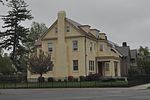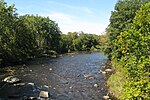Stone Dog
2013 sculpturesAnimal sculptures in MassachusettsBuildings and structures in Springfield, MassachusettsGranite sculptures in MassachusettsOutdoor sculptures in Massachusetts ... and 2 more
Sculptures of dogs in the United StatesTourist attractions in Springfield, Massachusetts
Stone Dog II is a granite statue of a golden retriever posed standing guard in front of the Zoo at Forest Park in Springfield, Massachusetts. This 2013 statue, crafted by Getty Granite in Connecticut, replaced the original Stone Dog which went missing from the park in 1987, and continues a tradition with roots in the late 19th century. The present statue is almost identical to the original, measuring about 2.5 feet tall, 4 feet long, and 2 feet wide, and weighing approximately 1,000 pounds.
Excerpt from the Wikipedia article Stone Dog (License: CC BY-SA 3.0, Authors).Stone Dog
Sumner Avenue, Springfield
Geographical coordinates (GPS) Address Phone number Nearby Places Show on map
Geographical coordinates (GPS)
| Latitude | Longitude |
|---|---|
| N 42.07671 ° | E -72.566585 ° |
Address
The Zoo in Forest Park & Education Center
Sumner Avenue 293
01108 Springfield
Massachusetts, United States
Open on Google Maps











